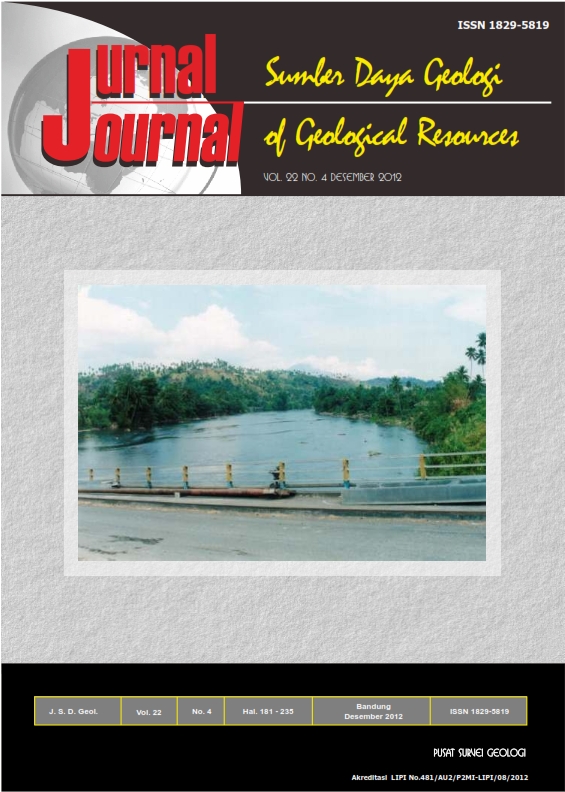PERBANDINGAN CALORIFIC VALUE BERAGAM BAHAN BAKAR MINYAK YANG DIPASARKAN DI INDONESIA MENGGUNAKAN BOMB CALORIMETER
DOI:
https://doi.org/10.33332/jgsm.geologi.v22i4.121Abstract
Calorific value is amount of released energy when a known volume of gas is completely combusted. Now, the market of fuels in Indonesia is not only owned by Pertamina, but there have been many gas stations conducted by foreign companies since 2005. One of the most famous ways to rank the fuels' performance is based on research octane number (RON). A different kind of fuels' calorific value with various octane number sold in many gas stations would be important information for fuel customers. The use of the bomb calorimeter to analyze the calorific value has been published in diverse applications. Although bomb calorimeter is viable to measure the heat content of the liquid, we can not easily find a writing of using the equipment on this kind of sample. The method used here has been successful to measure the calorific values of three liquid samples using bomb calorimeter. This study quantifies calorific value of eight gasoline and five diesel samples of 83 measurements. Statistics measurements of at least six times repetition indicate: the method have very good stability (%RSD = 0.09 – 0.63%), there are differences in colorific value on samples with same octane number produced by different company, increase in octane number also raises the samples' calorific value, and the ratio of fuel's price to their heat content is still lame.
Keywords : bomb calorimeter, calorific value, fuel, octane number
Downloads
References
Akers, S.M., Conkle, J.L., Thomas, S.N., dan Rider K.B., 2006. Determination of Heat Combustion of Biodiesel Using Bomb Calorimetry. Journal of Chemical Education, 83: 260-262.
Assi, R., 2008. The Relation Between Gasoline Quality, Octane Number and the environment. Jordan's Second National Communications on Climate Change. Amman – Jordania.
Doyle, T.K., Houghton, J.D.R., McDevitt, R., Davenport, J., dan Hays, G.C., 2007. The Energy Density of Jellyfish: Estimate from bom-calorimeter and proximate-composition. Journal of Experimental Marine Biology and Ecology, 343: 239-252.
Jenkins, B.M., Baxter, L.L., Miles Jr, T.R., Miles T.R., 1998. Combustion properties of biomass. Fuel Processing Technology, 54: 17-46.
Kumar, R., Pandev, K.K., Chandrashekar, N., dan Mohan, S., 2011. Study of age and height wise variability on calorific value and other fuel properties of Eucalyptus hybrid, Acacia auriculaeformis and Casuarina equisetifolia. Biomass and Bioenergy, 35: 1339-1344.
Nunez-Regueira, L., Rodriguez-Anon, J., Proupin-Castineras, J., Vilanova-Diz, A., dan Montero-Santovena, N., 2001. Determination of Calorific Values of Forest Waste Biomass by Static Bomb Calorimeter. Thermochimica Acta, 371: 23-31.
Nunez-Regueira, L., Rodriguez-Anon, J., dan Proupin-Castineras, J., 2004. Using Calorimetry for Determination the Risk Indices to Prevent and Fight Forest Fires. Thermochimica Acta, 422: 81-87.
Irzon, R. dan Permanadewi S., 2012. Nilai Kalor Tiga Jenis Sampel Cair Menggunakan Bomb Calorimeter. Prosiding Pertemuan Ilmiah Standarisasi, Bali.
Rubin, E.S., Chen, C., Rao, A.B., 2007. Cost and performance of fossil fuel power plants with CO2 capture and storage. Energy Policy, 35: 4444-4454.
Swinscow, T.D.V., 1997. Mean and Standard Deviation. In: Swinscow, T.D.V. Statistic at Square One. BMJZ Publishing Group, Shouthampton.
Wadső, L., Smith, A.L., Shirazi, H., Mulligan, R., dan Hofelich, T., 2001. The Isothermal Heat Conduction Calorimeter: A Versatile Instrument for Studying Process in Physics, Chemistry, and Biology. Journal of Chemical Education, 78: 1080-1087.
-, 2012. Heptane. http://en.wikipedia.org/wiki/Heptane/(21 November 2012).
-, 2012. 2,2,4-Trimethylpentane. http://en.wikipedia.org/wiki/2,2,4-Trimethylpentane/(21 November 2012)
Downloads
Published
Issue
Section
License
Authors who publish articles in Jurnal Geologi dan Sumberdaya Mineral (JGSM.Geologi) agree to the following terms:
- Authors retain copyright of the article and grant the journal right of first publication with the work simultaneously licensed under a CC-BY-NC or The Creative Commons Attribution–ShareAlike License.
- Authors are able to enter into separate, additional contractual arrangements for the non-exclusive distribution of the journal's published version of the work (e.g., post it to an institutional repository or publish it in a book), with an acknowledgment of its initial publication in this journal.
- Authors are permitted and encouraged to post their work online (e.g., in institutional repositories or on their website) prior to and during the submission process, as it can lead to productive exchanges, as well as earlier and greater citation of published work (See The Effect of Open Access)










